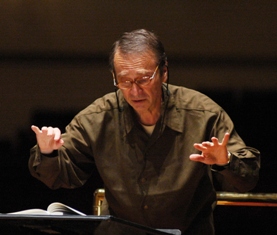
Grin's Tchaikovsky Revelatory
There was a pinnacle moment during Tchaikovsky’s Fifth
Symphony (Oct. 31) Friday morning at Music Hall.

It was toward the end of the final movement when Leonid Grin, guest conducting the Cincinnati Symphony Orchestra, dispensed with the baton and began conducting entirely with his hands. It was the moment he had been building toward throughout the work, the moment when the composer finally unleashes the brass in the great march that transforms the symphony from despair into triumph.
It was only the most exciting moment during
a revelatory performance that swept the matinee audience to its feet. Tchaikovsky, says Grin, is not as he is often
viewed, i.e. sentimental or hyper-romantic, but flesh-and-blood humanity in all
its complexity. (Not incidentally, Grin
was trained in conducting at the Peter Ilyich Tchaikovsky Conservatory in Moscow.)
Grin’s vision was clear in the opening bars of the symphony, which were taken super softly and more slowly than the Andante marking would suggest. The feeling was of dark, veiled sorrow (Grin characterizes it as a “danse macabre”). Upon repeat, the theme took on more passion and inner pulse, but the mood never let up, ending in an extraordinary bass coloration that vibrated with emotion (bassoon, timpani, cellos and basses).
The second movement (Andante cantabile) added tenderness to the mix, with a lovely solo by principal French hornist Elizabeth Freimuth and hesitant, almost lullaby-like strings on the contrasting second theme. Grin’s ability to imbue the texture with transparency (for which he thanks Tchaikovsky, he said) was beautifully manifest in the “conversation” among violins and winds that took place when the horn theme returned. It was a highly emotional, detail-oriented reading, with Grin shushing the strings at the end so that the clarinet’s dying tones could be heard.
By contrast, the third movement Valse (Waltz) was brisk and amiable, with a Trio section that called for nimble playing by the strings and principal bassoonist William Winstead. It was a perfect setup for the dignity and majesty of the finale.
Overall, it was an all-too-rare performance of a frequently hackneyed work and one that will not be soon forgotten by those lucky enough to hear it.
Guest artist was violinist Tai Murray in
Samuel Barber’s Violin Concerto. Murray,
who made an auspicious CSO debut at Riverbend in 2006, confirmed the impression
she made then. Hers was an under-stated,
but very moving approach to this neo-romantic work, one woven of silken lines
and pinpoint intonation. The slow movement
featured beautiful ensemble playing with the CSO musicians, followed by a
zestful, moto perpetuo finale.

Grin opened the concert with Dvorak’s Scherzo capriccioso, a rewarding work that, after a little stumble by the violins, was filled with spirit and color. There was muscular playing by the horns and a lovely solo by harpist Gillian Benet at the end.